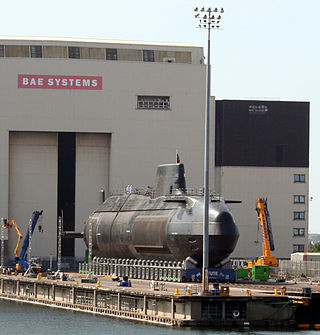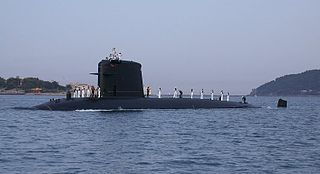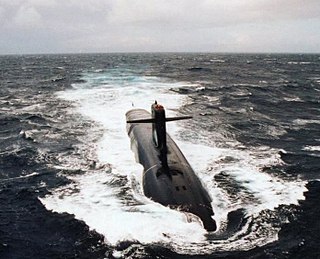
The Seawolf class is a class of nuclear-powered, fast attack submarines (SSN) in service with the United States Navy. The class was the intended successor to the Los Angeles class, and design work began in 1983. A fleet of 29 submarines was to be built over a ten-year period, but that was reduced to 12 submarines. The end of the Cold War and budget constraints led to the cancellation of any further additions to the fleet in 1995, leaving the Seawolf class limited to just three boats. This, in turn, led to the design of the smaller Virginia class. The Seawolf class cost about $3 billion per unit, making it the most expensive United States Navy fast attack submarine and second most expensive submarine ever, after the French Triomphant-class nuclear-powered ballistic missile submarines.

The Virginia class, also known as the SSN-774 class, is a class of nuclear-powered cruise missile fast-attack submarines, in service in the United States Navy. Designed by General Dynamics Electric Boat (EB) and Huntington Ingalls Industries, the Virginia class is the United States Navy's latest submarine model, which incorporates the latest in stealth, intelligence gathering, and weapons systems technology.

The Trafalgar class is a class of nuclear-powered fleet submarines (SSNs) in service with the Royal Navy, and the successor to the Swiftsure class. Like the majority of Royal Navy nuclear submarines, all seven boats were constructed at Barrow-in-Furness shipyard, Cumbria. With only one boat remaining active and in commission and six retired from the seven originally in service, the class makes up part of the Royal Navy's nuclear-powered ‘hunter-killer’ submarine force. The Trafalgar class has nearly been replaced by the larger and more capable Astute class, of which five are currently commissioned.

A ballistic missile submarine is a submarine capable of deploying submarine-launched ballistic missiles (SLBMs) with nuclear warheads. The United States Navy's hull classification symbols for ballistic missile submarines are SSB and SSBN – the SS denotes submarine, the B denotes ballistic missile, and the N denotes that the submarine is nuclear powered. These submarines became a major weapon system in the Cold War because of their nuclear deterrence capability. They can fire missiles thousands of kilometers from their targets, and acoustic quieting makes them difficult to detect, thus making them a survivable deterrent in the event of a first strike and a key element of the mutual assured destruction policy of nuclear deterrence.

An attack submarine or hunter-killer submarine is a submarine specifically designed for the purpose of attacking and sinking other submarines, surface combatants and merchant vessels. In the Soviet and Russian navies they were and are called "multi-purpose submarines". They are also used to protect friendly surface combatants and missile submarines. Some attack subs are also armed with cruise missiles, increasing the scope of their potential missions to include land targets.

USS Barracuda (SSK-1/SST-3/SS-550), the lead ship of her class, was a submarine that was the third ship of the United States Navy to be named for the barracuda, a voracious, pike-like fish. Her keel was laid down on 1 July 1949 by the Electric Boat Division of General Dynamics Corporation in Groton, Connecticut. She was launched on 2 March 1951 as K-1, sponsored by Mrs. Willis Manning Thomas, and commissioned on 10 November 1951. Notably, future President of the United States Jimmy Carter served as an officer on K-1 as part of its pre-commissioning crew and during its first year of active service until he was reassigned on 16 October 1952.

USS Bass (SSK-2/SS-551), a Barracuda-class submarine, was the second ship of the United States Navy to be named for the bass, an edible, spiny-finned fish. She was originally named USS K-2 (SSK-2).
A barracuda is a predatory fish found in tropical and subtropical oceans.

Submarine warfare is one of the four divisions of underwater warfare, the others being anti-submarine warfare, mine warfare and mine countermeasures.

A nuclear submarine is a submarine powered by a nuclear reactor, but not necessarily nuclear-armed. Nuclear submarines have considerable performance advantages over "conventional" submarines. Nuclear propulsion, being completely independent of air, frees the submarine from the need to surface frequently, as is necessary for conventional submarines. The large amount of power generated by a nuclear reactor allows nuclear submarines to operate at high speed for long periods, and the long interval between refuelings grants a range virtually unlimited, making the only limits on voyage times being imposed by such factors as the need to restock food or other consumables.

The Barracuda-class submarines were the product of Project Kayo, a research and development effort begun immediately after World War II by the United States Navy to "solve the problem of using submarines to attack and destroy enemy submarines." They originally had the hull classification symbol SSK, for "hunter-killer submarine".
The Barracuda class is a nuclear attack submarine, designed by the French shipbuilder Naval Group for the French Navy. It is intended to replace the Rubis-class submarines. Construction began in 2007 and the first unit was commissioned on 6 November 2020. The lead boat of the class, Suffren, entered service on 3 June 2022.

An SSN is a nuclear-powered general-purpose attack submarine. SSN is the US Navy hull classification symbol for such vessels; the SS denotes a submarine and the N denotes nuclear power. The designation SSN is used for interoperability throughout NATO under STANAG 1166, though navies use other terms.

Saphir was a first-generation nuclear attack submarine of the French Navy. Saphir was the second of the Rubis series. The boat was originally to be named Bretagne, but the name was changed to Saphir before commissioning in 1981.

The Attack-class submarine was a planned class of French-designed submarines for the Royal Australian Navy (RAN), expected to enter service in the early 2030s with construction extending until 2050. The project, which would have replaced the Collins-class submarines began in 2007 as the Future Submarine program. In 2020 to it was estimated to cost A$90 billion and would have been the largest and most complex defence acquisition project in Australian history.

The Submarine Forces of France are one of the four main components of the French Navy. The force oversees all French submarines regardless of role.
SSK was the United States Navy hull classification symbol for a diesel-electric submarine specialized for anti-submarine duties. SS indicated that the vessel was a submarine, and the K suffix that it was a hunter-killer. The United States Navy does not currently operate any submarines of this type, and so the designation is inactive.

Suffren (Q284) is a French nuclear attack submarine. It is the lead ship of the Suffren class, stemming from the Barracuda programme. The vessel was laid down on 19 December 2007 and launched on 1 August 2019 at Cherbourg. It was commissioned on 6 November 2020; while full operational service had originally been anticipated in 2021, this was pushed back into 2022 after further testing/trials by the Marine nationale. Pursuant to testing the submarine was then declared fully operational on 3 June 2022.
The SSN(X) program, also known as the Next-Generation Attack Submarine program, is a United States Navy program to develop a class of nuclear attack submarines to succeed itsVirginia-class andSeawolf-class attack submarines. The SSN(X) program is still in the early stages of development and no official details have been released about its design or capabilities.













